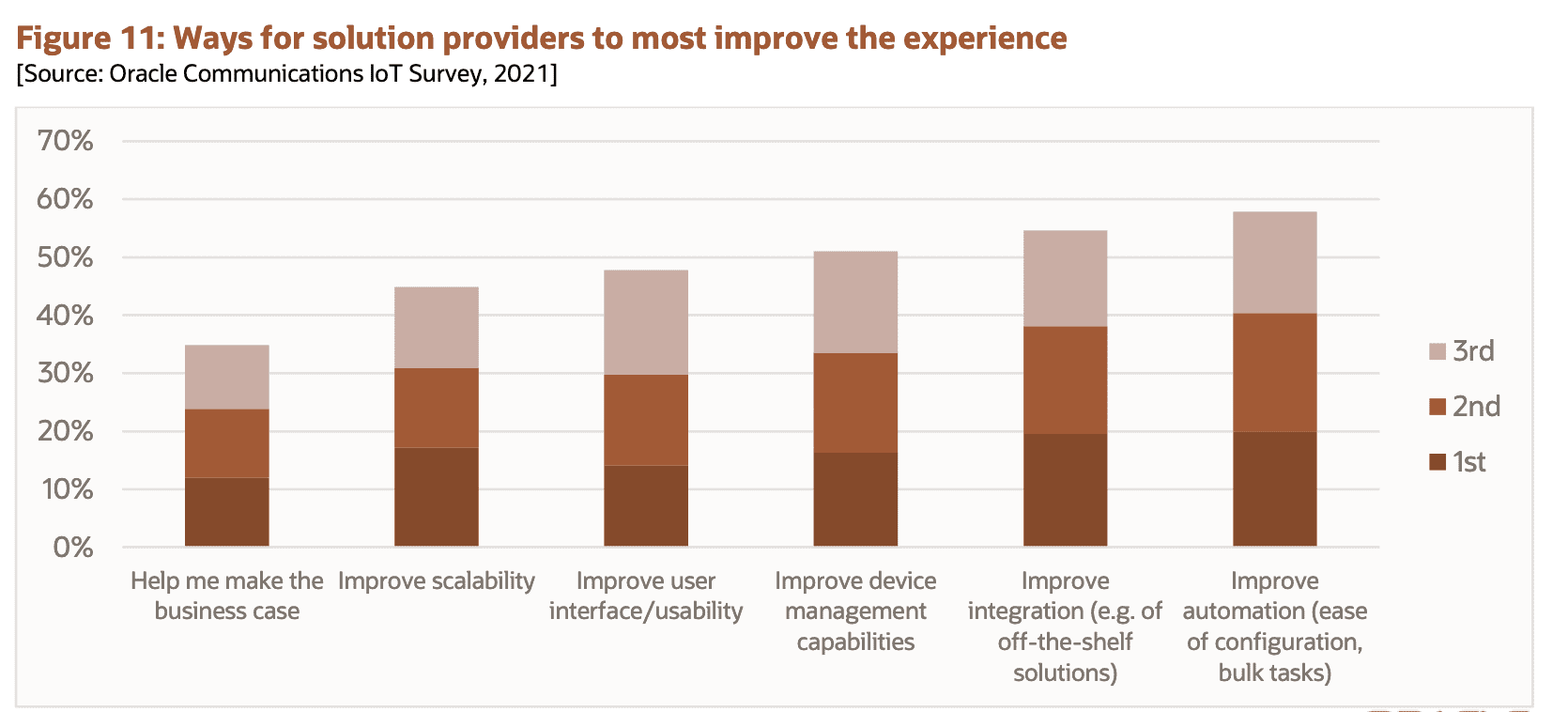From IoT for internal efficiency to external productivity
A new report by analyst house Transforma Insights for IT hardware and services provider Oracle says enterprise internet of things adoption has turned a corner, and gained some newfound maturity. It is a decent read, which draws from the experiences of 800-odd enterprises, mostly in Europe and North America, that are perceived to have made a good fist of IoT already. In short, they say deployments are relatively quick, and generally crucial (or important). Notably, they have also shifted their focus from internal efficiency drives to external productivity strategies.
The sample represents “some of the most sophisticated deployers and deployments”; respondents, all in IoT “recommender or decision-maker” roles for companies with 500-plus staff, are drawn variously from the enterprise IT, construction, real estate, utilities, healthcare, retail, public safety, and government sectors. Deployments are happening fast, and getting faster, they say; 8.5 months from start to finish, compared with an industry average of 11 months.
 This new speed is, possibly, down to interest in commercial off-the-shelf (COTS) solutions, versus customised and proprietary installs. Two thirds (64 percent) prefer COTS hardware and software, the report says. Meanwhile, three quarters want device connectivity, cellular or otherwise, bundled in from the start by the solution provider; most do not want to source airtime separately. The rest (25 percent) are happy for it to remain “opaque”, the story goes.
This new speed is, possibly, down to interest in commercial off-the-shelf (COTS) solutions, versus customised and proprietary installs. Two thirds (64 percent) prefer COTS hardware and software, the report says. Meanwhile, three quarters want device connectivity, cellular or otherwise, bundled in from the start by the solution provider; most do not want to source airtime separately. The rest (25 percent) are happy for it to remain “opaque”, the story goes.
It is the same with data and analytics; an even greater proportion (70 percent) want the solution provider to bundle these tools into their offer from the start, instead of navigating app-layer provision in the IoT tech stack by themselves. The report also asked who these old(er) hands want to work with, as a primary provider, by ranking their top three vendor choices. Half (56 percent) placed platform providers in their top three; a quarter (25 percent) put them top.
 Systems integrators (SIs) ranked second (42 percent and 14 percent put them top-three and top, respectively; business software vendors came third (33 percent and nine percent). More profoundly, the survey found IoT projects among leading IoT adopters are moving from inward-looking efficiency drives, consistently green-lighted for critical operations, towards outward-looking business functions, including to prospect for new revenue streams.
Systems integrators (SIs) ranked second (42 percent and 14 percent put them top-three and top, respectively; business software vendors came third (33 percent and nine percent). More profoundly, the survey found IoT projects among leading IoT adopters are moving from inward-looking efficiency drives, consistently green-lighted for critical operations, towards outward-looking business functions, including to prospect for new revenue streams.
A statement says: “Historically, a substantial majority of IoT projects have been focused on ‘low-hanging fruit’ of internal efficiency savings, such as supply chain logistics or condition monitoring for production equipment. For these top-tier adopters the balance has now shifted, with projects evenly split between internal efficiency-saving projects and external client-facing projects. This illustrates a growing sophistication in how IoT is being used.”
Transforma Insights says in the report that 30 percent of IoT projects, among the top-tier, are described as “fundamental” to core business, and that almost 90 percent are described as “fundamental” or “very important” to core business. It says: “The importance of this must be tempered by the fact that we were surveying adopters of sophisticated IoT deployments. Nevertheless, a figure of 90 percent is impressive.”
 As mentioned above, the report makes for a good read, and includes considerably more context and insight; it can be found here. In the meantime, taken verbatim from the report, here are five lessons (or ‘best practices’) for deploying IoT – from those in the know. The text below is lifted directly from the document; credit goes to Transforms Insights and Oracle.
As mentioned above, the report makes for a good read, and includes considerably more context and insight; it can be found here. In the meantime, taken verbatim from the report, here are five lessons (or ‘best practices’) for deploying IoT – from those in the know. The text below is lifted directly from the document; credit goes to Transforms Insights and Oracle.
1 | Don’t limit yourself to non-critical systems
The premier league of IoT adopters that we have surveyed are aggressively adopting IoT for critical systems, including those that directly touch their customers. There has been a tendency to “play it safe” with IoT deployments and look for low-hanging fruit, particularly in non-core parts of the business. Top adopters have turned that on its head and are overwhelmingly focused on highly transformational projects.
2 | Connectivity should be baked in
As it becomes more mature, IoT connectivity is increasingly becoming an opaque part of IoT solutions and offerings. Connecting a device is just the start, and no longer the most challenging part of a solution. Any IoT solution you buy will increasingly have connectivity as just a feature.
3 | Work out what you need to do with your data
Considerations of data have overtaken those of connectivity as the prime area of interest for top tier IoT adopters. However, just having all possible data delivered without any serious consideration of how you’re using it, and capturing the associated value, is a waste.
4 | Start with off-the-shelf products
The IoT solutions market used to be dominated by custom-built solutions but today productized solutions are most common. The rich array of off-the-shelf solutions tick most boxes of enterprise IoT deployments, and those offers can be the first port of call for any enterprise. IoT platform providers and other solution providers tend to have great IoT knowledge which adopters can tap into.
5 | Focus on business model to get ahead of the pack
To accelerate ahead of this top tier of IoT adopters, you should focus on business models. These leaders have moved from connectivity to data but perhaps have yet to make the leap to fully evolving their business models. You should look at how to capture full value of application exhaust data, and ensure IoT is fully integrated into enterprise processes, including all control flows. That’s how to truly embrace IoT.

